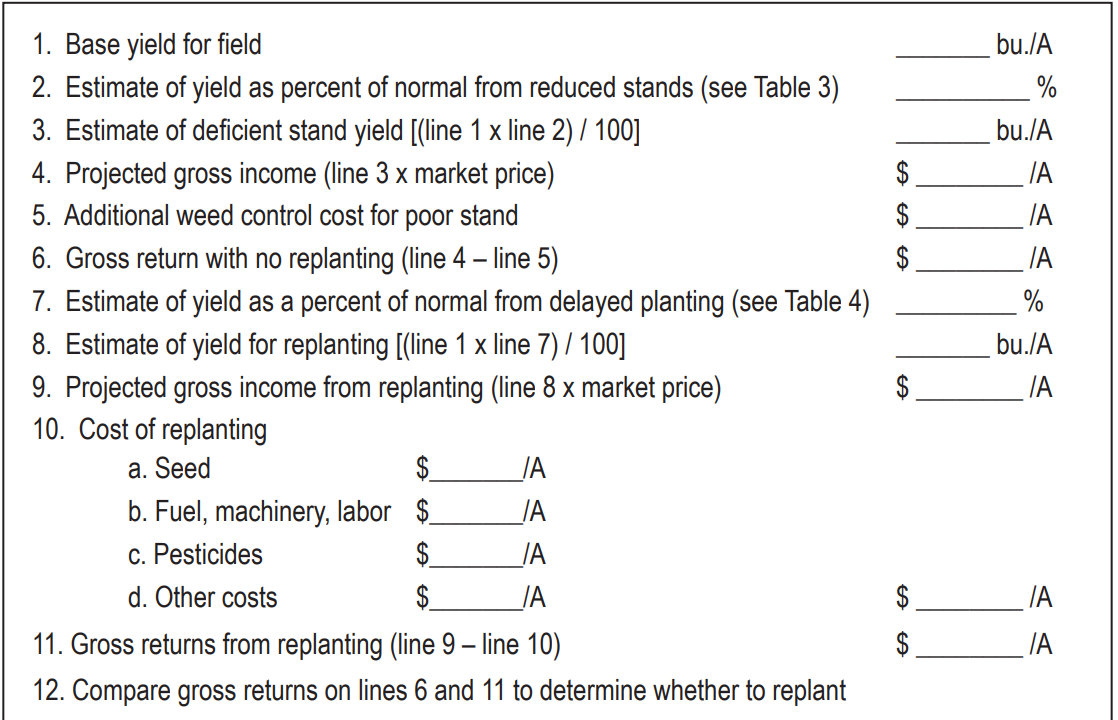ILSOYADVISOR POST
Should You Replant Soybeans? Probably Not
May 06, 2020
As of May 3rd, 31% of the soybeans in the state of Illinois had been planted, well above the five-year average of 12%. Near perfect soil conditions and warm temperatures in early April, coupled with increasing awareness of the benefits of early planting, led growers to plant more of the crop earlier than ever before. By April 24, quite a few growers in some regions of the state were reporting 100% completion of soybean planting.
Barring catastrophic weather events, the vast majority of the early planted fields will meet or exceed yield expectations. However, there may be isolated cases where growers will need to make replant decisions. When considering replanting, there are several factors that growers need to consider.
Cause of the Poor Stand
When a field has an undesirable emerged population, it is important to investigate the origin of the problem. If there is no way to mitigate the cause, replant will likely not be effective. If the problem is localized to certain areas of the field such as with ponding, the decision is generally an easy one since there may be near zero-percent stand in certain portions of the field.
Initial Plant Population
When considering replanting, the most important step is for growers to accurately judge plant populations. Soybean stands are generally underestimated, especially in 15-inch rows. Several areas of the field should be counted to obtain an accurate representation. Common methods for estimating plant stand across a field include counting the plants in 1/1,000th acre worth of row or using the hula hoop method. Tables which convert these counts into plants per acre are easily accessible online or in this article on ILSoyAdvisor from John Brien. However, be aware that these methods are subject to bias, as it is very easy to unconsciously select worse (or better) areas in which to conduct these counts.
The University of Illinois has an online stand count calculator, which can be used in conjunction with a measuring wheel to evaluate stands using the following steps:
- Set the measuring wheel to zero and push it down a row while counting plants.
- When you reach 150 plants, record how far the wheel has traveled in feet.
- Enter the data into this corn stand count calculator, which also works for soybeans and can be accessed at: http://extension.cropsciences.illinois.edu/fieldcrops/production/corn_stand_count/
This unbiased method for measuring population reduces the number of areas that need to be counted for an accurate stand estimate.
Replant Date
Once the field’s stand has been accurately assessed, the information can be used to make a replant decision. Soybean population effect on yield can vary due to soybean plants’ ability to compensate by producing more yield per plant at lower populations. In general, a uniformly established population of 75,000-80,000 plants/acre should be sufficient to provide 90% or better of maximum yield. If your population is below this threshold the calendar date must be taken into consideration, as University of Illinois data indicates that yield potential drops by about a quarter bushel per day after May 1, with the losses accelerating as the calendar turns to June.
I would like to note that although a population of 80,000 should provide good yield potential, it is not recommended to use populations this low as a seeding rate. The number of seeds planted per acre should be high enough to account for the seeds that will not germinate or will fail to emerge, especially in cooler soils. In most cases, a planted population in the 120,000-130,000 range should be sufficient to account for variation in seedling survival.
Input Costs
Obviously, the benefits of a replant must outweigh the costs in order to make sense. Purdue University has a document which aids growers with replant decisions and includes a worksheet that can be used to calculate factors including additional seed, fuel, pesticide and other costs.

Table 1: Purdue University worksheet used to account for the factors that go into making a replant decision.
Although there are situations in which a soybean field should be replanted, in most cases the benefit probably does not justify the cost. Often the yield of a lower population planted earlier will equal or exceed that of a higher population planted later. Also, remember that although weed management may present more of a challenge in low populations, replanted fields will also canopy later and may require additional weed control. If you are considering a replant, visit with a trusted agronomist to determine if it is truly warranted.





Comments
Add new comment